Pacu
In the Pantanal, the Pacu (Piaractus mesopotamicus) is one of the most important fish species for amateur and professional fishing, being captured in considerable quantities. It's a fruit-eating relative of the piranha - but isn't above grabbing other morsels which present themselves.
As with the piranha, the pacu's dental hardware is impressive - except, rather than scary knife-like triangular teeth of the piranha, pacu have square molars that look surprisingly human. These are perfectly adapted for eating fruits and nuts which drop into the waters of the Pantanal, along with other occasional non-vegetarian morsels. Pacu are omnivorous - essentially eating anything that comes their way. Although not a danger to people within their natural environment, they can be more dangerous if transported into other locations lacking their natural food. For example, fish introduced into the Sepik river of Papua New Guinea in the 1990s have reported as attacking other species and even people. In recent times, Pacu have even gained a (we think unfounded) reputation for attacking male genitalia. Hence the nickname: "Ball cutter"
 Pacu testicle-eating debunked
Pacu testicle-eating debunked
The name pacu is associated primarily with three similar species of fish. All have the same general appearance and behaviour, and are prized by the local people for their sweet-tasting meat
The pacu-caranha inhabits the waters of the Pantanal, along with other rivers in southern Brazil, Uruguay, northern Argentina, Paraguay and Bolivia. In some areas such as dams and ponds, where not naturally occurring, it has been introduced to support local fishing. It can often be found underneath fruiting trees - waiting for the fruits, seeds, or other vegetable matter to fall into the water. During the annual floods, pacu leave the main river channels - entering the waters around the flooded gallery forests, where higher waters sometimes enable them to eat the fruits directly off the trees - and has the ability to search for food in very shallow water if required. Aside from fruits, pacu will also feed on aquatic insects, plankton, snails, crabs and other small fish. It's omnivorous and opportunistic diet has resulted in the local nickname "porco do rio" (pig of the river), suggesting that it will eat anything which comes its way. Research has shown that pacu have an important role with the dispersal seeds, with at least 43 pantanal plant species (representing about 25 percent of gallery forest diversity) being reliant on pacu, at least in part, for their propagation. Many local fruits contain an outer pulp surrounding a hard inner seed. The seeds, when ingested aren't always crushed by the pacu's jaws. They are scarified by the fish's digestive system, then excreted, often far from the parent tree. This pattern of seed dispersal is likely true also for riverine Amazon plant species.
The behaviour and diet of the tambaqui and pirapitinga of the Amazon region are broadly similar. However, these prefer the warmer tropical waters of northern Brazil, northeastern Bolivia, Peru, Colombia and Venezuela.
Pacu are migratory. The plentiful food available during the wet season allows them to build up fat reserves to help get them through the scarcity of the dry season, and to fuel their migration. This occurs during the piracema period of late spring and summer (Nov-Mar). They travel back upstream towards the sources of rivers and streams - where they mate and lay their eggs among reeds along the riverbanks. The young hatch during the high-water season, when there is plenty of food - and initially inhabit shallow areas on the edge of the gallery forests, moving back closer to the main river channels as they mature. Pacu reach maturity at 3 or 4 years and, assuming they manage to avoid predators and fishermen, can live to exceed 25 years.
The name pacu is associated primarily with three similar species of fish. All have the same general appearance and behaviour, and are prized by the local people for their sweet-tasting meat
- Pacu-caranha (Piaractus mesopotamicus). This is the species encountered in the Pantanal. These are a wide oval shape, measuring up to 70 cm in length, and weighing up to 20 kg. Brown or grey in colour, with a yellowish underside.
- Pirapitinga (Piaractus brachypomus) or or pacu-negro. These are very similar, originating from the Amazon region. They measure up to 80 cm in length, weighing up to 25 kg. Dark grey, or black, with a reddish underside - and a second row of teeth along the upper jaw. This species is less popular as an eating fish - but popular with sports fishermen due to its reputation as a strong fighter. In the aquarium trade this species is known as the red-bellied pacu.
- Tambaqui (Colossoma macropomus). This also originates from the Amazon - measuring up to 90 cm in length, and weighing up to 30 kg. Grey or brown, with a black underside.
Behaviour and Habitat
The pacu-caranha inhabits the waters of the Pantanal, along with other rivers in southern Brazil, Uruguay, northern Argentina, Paraguay and Bolivia. In some areas such as dams and ponds, where not naturally occurring, it has been introduced to support local fishing. It can often be found underneath fruiting trees - waiting for the fruits, seeds, or other vegetable matter to fall into the water. During the annual floods, pacu leave the main river channels - entering the waters around the flooded gallery forests, where higher waters sometimes enable them to eat the fruits directly off the trees - and has the ability to search for food in very shallow water if required. Aside from fruits, pacu will also feed on aquatic insects, plankton, snails, crabs and other small fish. It's omnivorous and opportunistic diet has resulted in the local nickname "porco do rio" (pig of the river), suggesting that it will eat anything which comes its way. Research has shown that pacu have an important role with the dispersal seeds, with at least 43 pantanal plant species (representing about 25 percent of gallery forest diversity) being reliant on pacu, at least in part, for their propagation. Many local fruits contain an outer pulp surrounding a hard inner seed. The seeds, when ingested aren't always crushed by the pacu's jaws. They are scarified by the fish's digestive system, then excreted, often far from the parent tree. This pattern of seed dispersal is likely true also for riverine Amazon plant species.
The behaviour and diet of the tambaqui and pirapitinga of the Amazon region are broadly similar. However, these prefer the warmer tropical waters of northern Brazil, northeastern Bolivia, Peru, Colombia and Venezuela.
Reproduction
Pacu are migratory. The plentiful food available during the wet season allows them to build up fat reserves to help get them through the scarcity of the dry season, and to fuel their migration. This occurs during the piracema period of late spring and summer (Nov-Mar). They travel back upstream towards the sources of rivers and streams - where they mate and lay their eggs among reeds along the riverbanks. The young hatch during the high-water season, when there is plenty of food - and initially inhabit shallow areas on the edge of the gallery forests, moving back closer to the main river channels as they mature. Pacu reach maturity at 3 or 4 years and, assuming they manage to avoid predators and fishermen, can live to exceed 25 years.
The various species of Pacu have proven a popular aquarium fish in the US and Europe, often being sold as a "vegetarian piranha". Photo: Jasper Nance
Scientific Name
Piaractus mesopotamicus

Local Name
Pacu or
Tambaqui

Description
Large oval or rhomboid fish. Pantanal species can reach 70 cm in length, and weigh 20 kg. Grey or brown with a yellowish underside. Related Amazon species are larger still.
Notes for Fishing
Pacu are numerous in the Pantanal and are one of the most frequently encountered fish within the region. By contrast, in the Amazon, tambaqui are becoming increasingly rare due to intensive targeting by both commercial and subsistence fishermen. Pirapitanga remain numerous as these are preferred less for eating, and therefore less of a target. In recent years, many more international anglers have begun travelling into the Pantanal and Amazon regions, keen to try the fishing in more exotic locations and to pit themselves against the South American species. The pacu and tambaqui (along with the dorado) are proven favourites for anglers - but with pirapitinga also establishing a reputation as a strong fighter with a nature appealing to sports fishermen. Note that pacu less than 40 cm are protected by law.
Pacu teeth can be surprisingly human, including molars suited to the grinding of seeds and nuts. Photo: Henrik Carl
Local fishermen try attracting pacu by beating the water intermittently with a bamboo stick to simulate falling fruit, and using palm fruits as bait (fruits from the tucum or Astrocaryum vulgare palm are a popular choice). Other popular baits include oranges, crab meat, or cheese, sausage and even cookie dough containing a high fat content - which floats on the water, and is thought to carry the scent. A good steel hook with a strong nylon line should also be used to cope with the force exerted by such a large fish.
Conservation and Threats
Although not currently considered threatened, pacu species are vulnerable to habitat loss and pollution. However, the biggest risk is from overfishing. This is a significant issues - particularly in the Amazon region as both subsistence and commercial operations complete to bring in large quantities of pacu, which command strong prices on local and international markets. Local fishermen report that both the quantity and size of these fish is decreasing. Fewer fisher, and smaller size, means that the vital role they play in the dispersal of seeds and propagation of plant species is also at risk.
Dams and other barriers to natural migration paths can also interfere with pacu's reproductive cycle - resulting in fewer larvae or higher predation during their early development phases. Recent warnings by researchers have highlighted that reducing the population size also reduces the species' genetic diversity - presenting a further potential threat for survival.
Quick Facts
- The pacu move in shoals with dozens, sometimes hundreds of fish in streams and shallow channels, often mingling with piranha.
- Pacu are naturally timid. They usually maintain a good distance from swimmers and divers.
- Because of their food potential, pacu are increasingly being used for fish farming around the world. Within Brazil they've been bred to stock dams and ponds for fishing.
- A new hybrid species, the tambacu, has been developed for fish farming and aquaculture. This combines the larger size of the tambaqui with the pacu's resistance to colder water.
- Pacu, of various species, have proven to be a popular aquarium fish in the US and Europe. This may explain them occasionally turning up there in rivers and streams.
Related Links



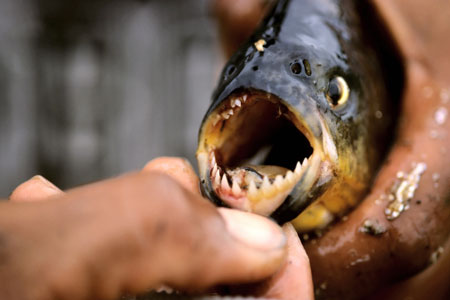
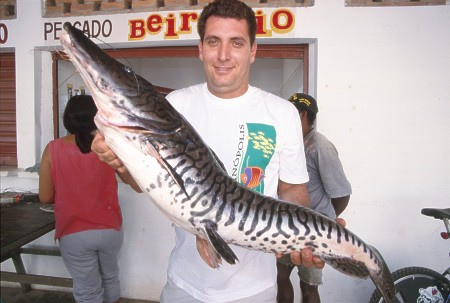
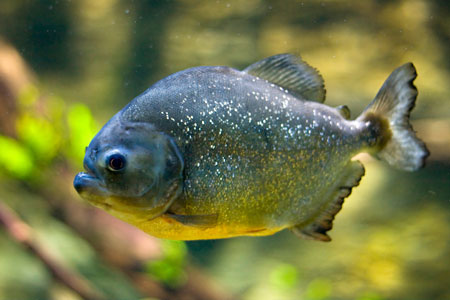


Banner image: Pacu (iStock/Ammit).
Footer images: Piranha teeth (Shutterstock/Chris Howey); Red-Bellied Piranha (Shutterstock/kostudio); Cachara catfish in Pantanal market (Andrew Mercer)
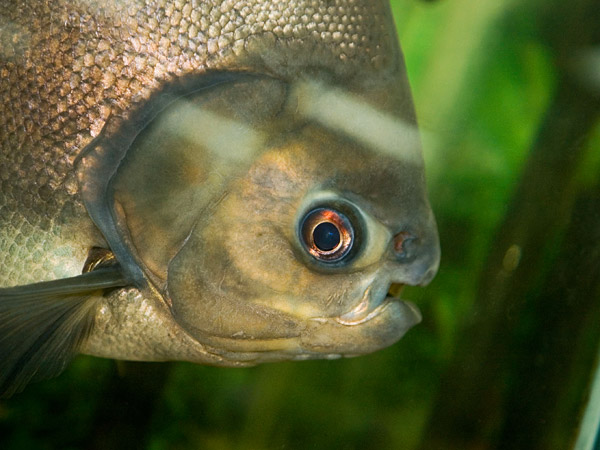
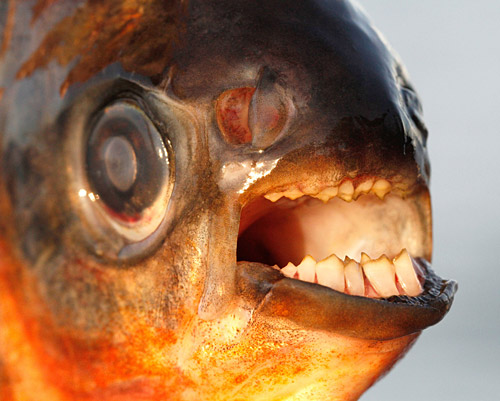
Pantanal Escapes